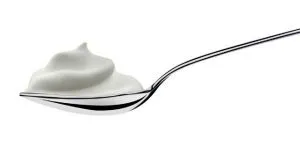
- Share on Facebook191
- Share on Pinterest
- Share on Twitter
One of the hottest topics in nutrition these days involves the mini microbes that help keep your gut function in top shape. As food scientists and researchers discover more and more about the fascinating role certain bacteria play in our immune system, probiotics have become a must-have health food.
Yogurt is a natural source of these mighty microbes, which are actually responsible for transforming liquid milk into its thick and creamy form. And while for centuries yogurt has been considered a health food, and in more recent times comprises full refrigerator cases dedicated to gut health in grocery stores, modern day yogurt just isn’t what it used to be. In fact, many popular brands are nothing more than junk food in disguise.
Yogurt is a big business in the United States. Each year, Americans spend about 6 billion dollars and eat an average of 13 pounds of the creamy treat. Real yogurt should contain nothing more than two ingredients, milk (preferably organic) and a number of cultures including Lactobacillus bulgaricus and Streptococcus thermophilus. Flip over the carton of many of the conventional brands lining dairy cases, however, and their ingredients lists read more like a chemistry book than a health food.
Chemical defoamers, high-fructose corn syrup, artificial colors, flavors and sweeteners along with a slew of preservatives and thickeners are among the top offending additives that comprise today’s yogurt. In fact, one controversial thickener, carrageenan, has been linked to inflammation as well as several digestive disorders.
It would seem counterproductive to add an ingredient that causes digestive upset to a product that is supposed to treat it, yet that doesn’t seem to stop manufacturers who are in direct competition with each other to produce a thicker, creamier yogurt. And lets not forget the brands marketed directly to children with their processed cookie bits, sprinkles and other chemical-coated candies added to this once-healthy treat.
Yet unsuspecting consumers continually purchase this yogurt under the false assumption that they are buying a health food. Many of these containers shouldn’t even legally be marketed as “yogurt.” According to the organic watchdog group, the Cornucopia Institute, many conventional yogurts contain dangerous additives that would forcibly remove these yogurt imposters from true yogurt’s “Standard of Identity” set forth by the FDA.
In a recent article published in the American Journal of Clinical Nutrition, researchers called for stricter regulations on just how companies market these new breeds of yogurt, citing that certain health claims are misleading consumers into believing their product is a health food while in fact it may be anything but.
And while you may be able to look beyond the added chemicals, sweeteners, thickeners and flavor-enhancers that comprise your favorite flavors in favor of those beneficial bacteria, you may want to take a closer look at which microorganisms are actually in each scoop.
The National Yogurt Association’s label of “Live and Active Cultures” that line many a brand leads consumers to believe they are getting a healthy dose of probiotics in their key lime-flavored yogurt. Yet according to an excerpt from Food Science: An Ecological Approach, all probiotics are considered “live and active cultures,” yet not all “live and active cultures” are actually probiotics, and therefore many lack the true benefits.
The Cornucopia Institute notes that the label is voluntary and most-utilized by major brand names like General Mills (Yoplait) and Groupe Danone (Dannon), as well as Walmart’s own line in an effort to attract health-conscious consumers.
So how do you know which brands to buy? Yogurt can be an excellent contribution to a healthy diet when the right varieties are selected. More importantly than anything is to buy organic.
This ensures that the milk comes from cows that haven’t been treated with antibiotics and hormones, nor were they fed a GMO-rich diet. Also, avoid “low-calorie” or “light” yogurts, as these often contain dangerous artificial sweeteners. Keep in mind that the more exotic the flavor, the greater likelihood that artificial chemicals need to be added.
 Blueberries are easy to add, Boston creme pie flavor, however, is harder to reproduce. And don’t be dissuaded if your organic brand doesn’t don the seal “Live and Active Cultures.” The Cornucopia Institute found that several organic brands that didn’t boast the popular seal contained more beneficial bacteria than the conventional brands that were labeled. Look instead for the presence of Lactobacillus bulgaricus and Streptococcus thermophilus, as these are known to benefit gut health.
Blueberries are easy to add, Boston creme pie flavor, however, is harder to reproduce. And don’t be dissuaded if your organic brand doesn’t don the seal “Live and Active Cultures.” The Cornucopia Institute found that several organic brands that didn’t boast the popular seal contained more beneficial bacteria than the conventional brands that were labeled. Look instead for the presence of Lactobacillus bulgaricus and Streptococcus thermophilus, as these are known to benefit gut health.
The bottom line is that like most foods, the fewer the ingredients, the healthier the product. If you must sweeten your yogurt, do it naturally by adding fresh organic fruit, raw honey or organic, crushed stevia leaf.
-The Alternative Daily
Sources:
http://www.naturalnews.com/044989_conventional_yogurt_junk_food_chemical_ingredients.html
http://www.cornucopia.org/2014/04/leaving-sour-taste-conventional-yogurt-masquerades-health-food-organic-keeps-real
http://www.aboutyogurt.com/Live-Culture
http://ajcn.nutrition.org/content/99/5/1271S.short
http://books.google.com/books?hl=en&lr=&id=aDI5Bmn7TRQC&oi=fnd&pg=PA238&dq=yogurt+benefits&ots=vBOvTtvVbl&sig=1Gnc_ymMZtTagib0PCL8Xk5iL8s#v=onepage&q=yogurt%20benefits&f=false
- Share on Facebook191
- Share on Pinterest
- Share on Twitter

